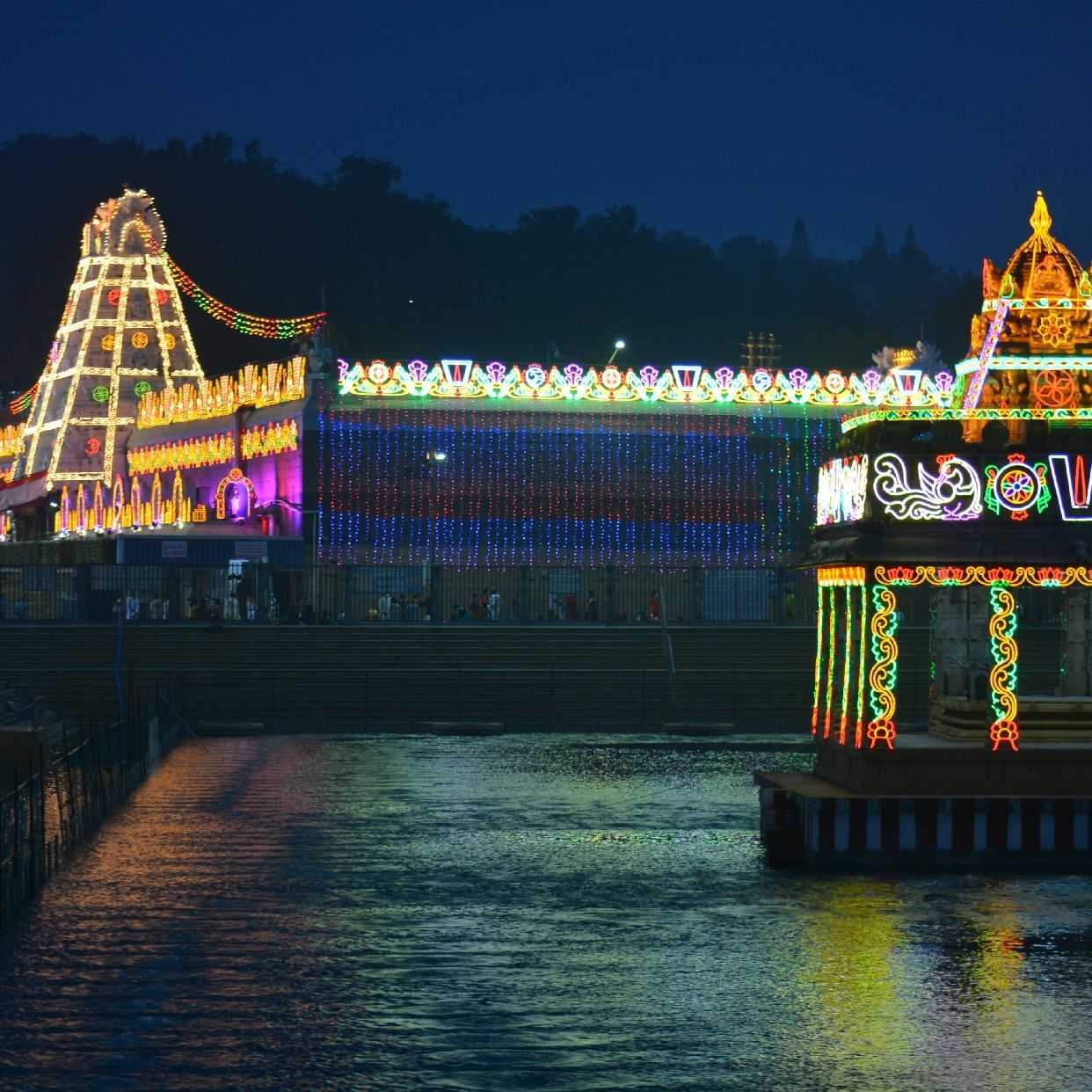
Srivari Brahmotsavam
Every day is a festival day in Tirumala and the Lord of Riches, Universal Lord Sri Venkateswara enjoys over 450 festivals in a year which includes daily, weekly, fortnightly, monthly, yearly festivals. Of them, the annual Brahmotsavams are considered most important as they are believed to have initiated by none other than Lord Brahma, the creator Himself.
Yearly Schedule
Spread over 9 days, schedule looks like below:
| Date | Morning | Evening |
|---|---|---|
| Day 1 | Dwajarohanam | Pedda Sesha Vahanam |
| Day 2 | Chinna Sesha Vahanam | Hamsa Vahanam |
| Day 3 | Simha Vahanam | Mutyapu Pandiri Vahanam |
| Day 4 | Kalpavriksha Vahanam | Sarva Bhoopala Vahanam |
| Day 5 | Mohini Avataram | Garuda Seva |
| Day 6 | Hanumantha Vahanam | Swarna Ratham, Gajavahanam |
| Day 7 | Suryaprabha Vahanam | Chandraprabha Vahanam |
| Day 8 | Rathotsavam | Aswa Vahanam |
| Day 9 | Snapana Tirumanjanam, Chakrasnanam | Dwajavarohanam |
Activities
The main activities carried out during Brahmotsavam are:
- Aalaya Suddhi
- Mritsangrahanam
- Dwajarohanam
- Vahana Seva
- Srivari Koluvu
- Snapanam
- Choornabhishekam
- Chakrasnanam
- Devatodwasanam
- Dhwajavarohanam
Aalaya Suddhi
Before the commencement of Brahmotsavam, the temple of Lord Sri Venkateswara is cleaned according to the guidelines given in the religious texts. The temple premises and its surroundings are decorated with flowers and mango leaves. This process is called Aalaya Suddhi and Alankaram (decoration).
Mritsangrahanam
Mritsangrahanam (the process of collecting earth) is carried out on the day prior to the first day of Brahmotsavam. The temple officials pray to deities like Vishvaksena, Anantha, Sudarshana and Garuda. They also pray to Mother Earth and collect a small quantity of earth, with which the Ankurarpanam ritual is conducted, by which the earth is spread in a room and nine kinds of cereals are sown in it.
Dwajarohanam & Devatavanam
Dwajarohanam (hoisting the flag or garudadhwaja) signals the start of the Brahmotsavam. It is carried out at the Dwajasthambham, near the Nadimi Padi Kavili inside the temple complex. The temple officials hoist the flag (with a picture of Garuda on it) to the chanting of Vedic mantras by the temple priests.
It is believed that Garuda goes to Devalokam to invite Gods like Brahma, Indra, Yama, Agni, Kubera and Vayudeva and sages like Vasistha and Vishwamitra.
Vahana Seva
The Lord is taken in a procession around the streets of Tirumala on different vahanas (vehicles). Each vahana has its own significance, and conveys the Lord’s message in its own way.
Srivari Koluvu
During Brahmotsavam, the Lord holds court in the main temple, after being taken around in a procession. The temple priests perform Naivedyam during this time.
Snapanam
Snapanam (also called the Utsavananthara Snapanam) is the process of bathing the Lord with herbal water after the procession. It is believed to relieve the strain the Lord has undergone during the procession.
Choornabhishekam
Choornabhishekam involves bathing the lord and his consorts after anointing them with sandalwood powder. This is done on the morning of the ninth day of the Brahmotsavam. The Lord is then taken in a procession around the streets of Tirumala. The temple priests distribute the sandalwood powder used for the Lord to devotees. It is believed that the sandalwood powder has the power of clearing obstacles from one's path.
Chakrasnanam
The Chakrasnanam ritual is akin to the bathing ritual after the performance of a yagna. On the morning of the last day of Brahmotsavam, the Lord, his consorts and Sri Sudarshanachakram are bathed in the Swami Pushkarini.
Devotees can also bathe in the Swami Pushkarini, along with Sri Sudarshanachakram. It is considered to be a very sacred ritual, and devotees participate in this ritual, irrespective of religion, caste or creed.
Devatodwasanam
On the last day of Brahmotsavam, the ritual of seeing off the rishis and Gods to Devalokam is called Devatodwasanam. It is performed after the daily archana. Lord Brahma is praised for organising the utsavam, and He is honoured by the temple priests and officials.
Dwajavarohanam
Dwajavarohanam or lowering the flag (hoisted on the first day of Brahmotsavam) is carried out on the evening of the last day of Brahmotsavam.
Brahmotsavam in 2023
Due to Adhikamasam, there will be 2 Brahmotsavams this year
Dates: September 18th - 26th, 2023
Dates: October 14th - 22nd, 2023
Click on any date to see celebrations
| Date | Morning | Evening |
|---|---|---|
| Sept 18th | Dwajarohanam5:15 - 6:15 pm | Pedda Sesha Vahanam9:00 - 11:00 pm |
| Sept 19th | Chinna Sesha Vahanam8:00 - 10:00 am | Hamsa Vahanam7:00 - 9:00 pm |
| Sept 20th | Simha Vahanam8:00 - 10:00 am | Mutyapu Pandiri Vahanam7:00 - 9:00 pm |
| Sept 21st | Kalpavriksha Vahanam8:00 - 10:00 am | Sarva Bhoopala Vahanam7:00 - 9:00 pm |
| Sept 22nd | Mohini Avataram8:00 - 10:00 am | Garuda Seva7:00 - 9:00 pm |
| Sept 23rd | Hanumantha Vahanam8:00 - 10:00 am | Swarna Ratham, Gajavahanam7:00 - 9:00 pm |
| Sept 24th | Suryaprabha Vahanam8:00 - 10:00 am | Chandraprabha Vahanam7:00 - 9:00 pm |
| Sept 25th | Rathotsavam7:00 - 9:00 am | Aswa Vahanam7:00 - 9:00 pm |
| Sept 26th | Snapana Tirumanjanam, Chakrasnanam6:00 - 9:00 am | Dwajavarohanam7:00 - 9:00 pm |

On the first day, Dhwajarohana is conducted by hoisting the Garudadhwaja (flag with the emblem of a black garuda), near the Srivari Alaya Dhwajasthambham.
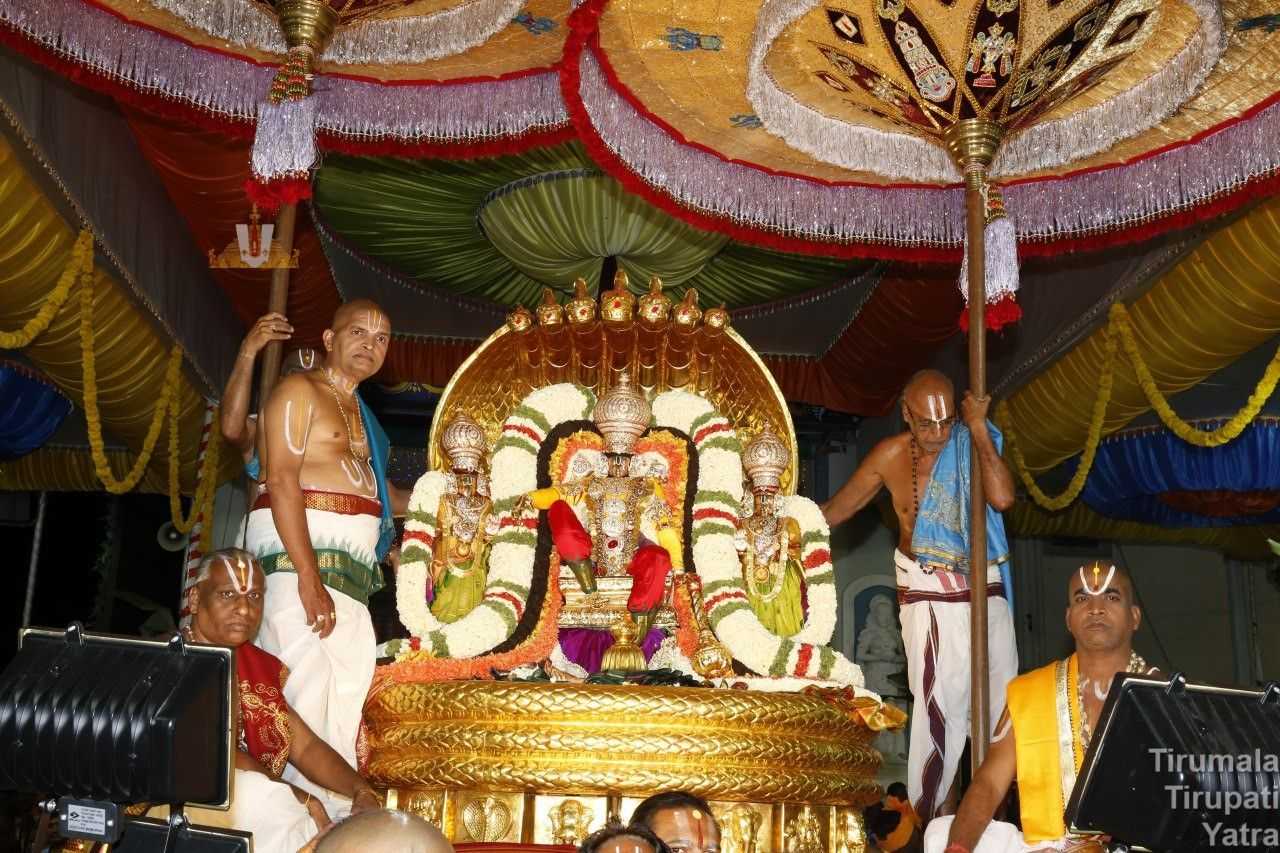
A spectacular procession of Lord Venkateswara on the Pedda Seshavahana is taken around the four streets of the main temple from 22:00 hrs till midnight.
The meaning of Sesha is "to serve". Adi Sesha is a thousand-headed serpent, on whom Lord Sri Maha Vishnu rests in his abode, Vaikuntam.
Tirumala Hills, the abode of Lord Sri Venkateswara, is believed to be the manifestation of Adisesha. In commemoration of this event, the Lord is carried in a procession around the streets of Tirumala on the Seshavahana (vehicle shaped like Adisesha) during the first two days of Brahmotsavam (Pedda Seshavahana and Chinna Seshavahana).

On the second day, the Lord is taken around the streets of the temple on the Chinna Seshavahana in the morning.

Hamsa or swan means 'pure'. Hamsa is believed to have a high intellectual capability, and can distinguish the good from the bad. In addition, Hamsa is visually appearing. It is for these reasons that Lord Brahma uses Hamsa not only as his vehicle, but also to chant the Vedas (the Vedas are believed to have emanated from the soul of Vishnu).

On the morning of the third day, the deities are carried on the Simhavahana.
Simha (lion) is a symbol of regality and power. According to the Bhagvad Gita, the Lord is the Simha among animals (mriganamcha mrigandroham). The Lord is also called Hari (which in turn means Simha) and Hari sits on Simha. In other words, we have the phenomenon of the Lord sitting on himself.
It is also believed that the Lord assumed the form of Narasimha (half man and half lion) to kill the demon Hiranyakasipu. Therefore, Lord Venkateswara uses the Simha as his vehicle on the third day of Brahmotsavam.

In the night, Unjal Seva is conducted. The deities then ride in the Mutayalapandiri Vahana, which is decorated with a pearl canopy. Mutyam (pearl) is a symbol of purity and royalty.

On the fourth day, the deities are carried in a Kalpavriksha Vahana in the morning.
Kalpavriksham is a tree that is believed to grant boons and fulfil devotees wishes. The vehicle shaped like the Kalpavriksham signifies that the Lord grants boons and fulfils the wishes of his devotees.

In the night, after the Unjal Seva, the deities are carried in a Sarvabhoopala Vahana.
Sarvabhoopala means 'all the kings of Mother Earth'. According to the Hindu religion, kings, like Lord Vishnu, should always protect their people (na vishnuhu prithivi pathihi).
To thank Lord Vishnu for his ideals and pray to him, the kings take the form of the Sarvabhoopala
On the fifth day, Mohini Avatarotsavam is celebrated to commemorate the Lord's incarnation as Mohini, in the morning.
According to legend, the Devatas and the Demons performed Ksheerasagaramadhanam that resulted in amrit (nectar which when consumed grants immortality) and other sacred qualities. The Devatas and the Demons fought for possession of the Amrit. Lord Vishnu then assumed the form of Mohini (a beautiful woman) and procured the Amrit for the Devatas.
The Lord is dressed like Mohini, and He is taken in a procession in a Pallaki (palanquin). Lord Krishna is also taken in the same procession. This is to celebrate the assistance rendered by Lord Vishnu to the Devatas during Ksheerasagaramadhanam
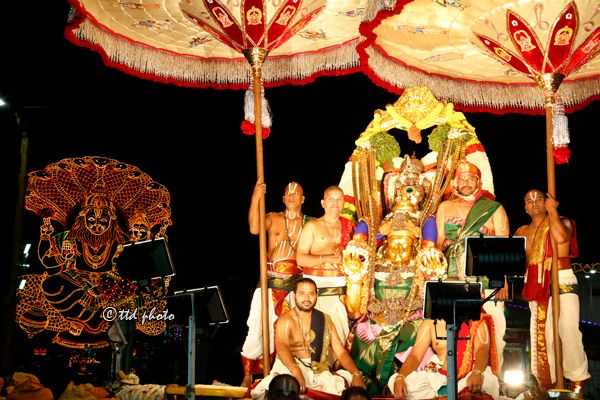
After the Unjal Seva in the night, the Lord and his consorts are seated on Garuda Vahana. Lord is decorated with Mahaakanti, Sahasranaramala that day.
According to the ancient Hindu texts, Garuda, the king of birds, is a replica of the Vedas (vedatma vihamgeswara), while Lord Vishnu is the God of the Vedas. Therefore, the Lord sees Himself in Garuda. In the Vaishnava Puranas, Garuda is also called periyatiruvadi, meaning the first devotee.
Therefore, Lord Venkateswara selected Garuda as his vehicle for the most important day of the Brahmotsavam. Garuda Vahana is the greatest of all the Vahanas. A large number of pilgrims visit the temple on this day.
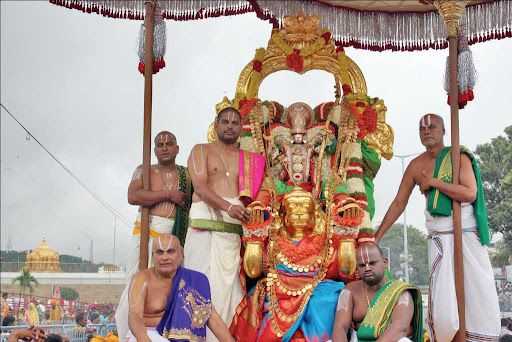
On the morning of the sixth day, the deities are carried on a beautifully-decorated Hanumad Vahana.
Hanuman was one of the greatest devotees of Sri Rama, an incarnation of Lord Vishnu. Hanuman served the Lord so faithfully, that even the Lord could not thank Hanuman enough. Devotees believe that they are indeed blessed if they catch a glimpse of the Lord on Hanumad Vahanam.

In the night, the Lord is mounted on the Gaja Vahana. Gajam (elephant) is also called the samajam (born from Samaveda). It symbolises wealth (gajamtam aishwaryam). It also symbolises the Airavatam – the vehicle of Devendra, the head of the heavens in Hindu mythology. It also can be attributed to the elephant in Gajendramoksham (story from the Mahabhaghavatam), which is saved from a crocodile by Lord Vishnu.
To thank Lord Vishnu for his ideals and pray to him, the kings take the form of the Sarvabhoopala Vahana on the fourth day of Brahmotsavam.
Therefore, the Lord is taken in a procession seated on a Gaja Vahana during Brahmotsavam.

On the morning of the seventh day, the Lord rides on Suryaprabha Vahana (Sun chariot).
Surya (the Sun), the son of Aditi, is another form of Lord Vishnu (Surya Narayana).
Hindu mythology supports the heliocentric theory, and believes that Lord Vishnu is the centre of the universe (dhyassada savitrumandala madhyavarthi). To symbolise this, Lord Venkateswara uses the Suryaprabha (light of the Sun) Vahana.
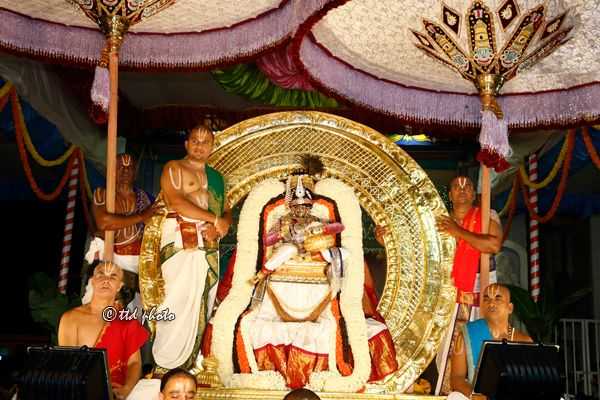
After the Unjal Seva in the night, the Lord is taken in the Chandraprabha Vahana (moon-shaped vehicle) around the brightly-lit streets of Tirumala.
Chandra means the Moon, which is considered cool and pleasant. According to Hindu mythology, Chandra is the commander of the mind (chandrama manaso jataha). He is also the king of aushadha (medicine).
It is believed that riding in the Chandraprabha Vahana is a soothing experience for the Lord. The Lord's contentment will bring peace to devotees' minds and result in a good crop.
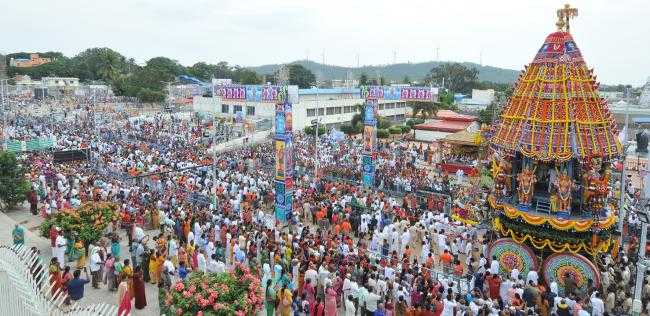
On the penultimate day, Rathotsavam is celebrated, in which the Lord is seated in a ratham (chariot) and taken in a procession in the morning.
It is believed that those who witness Rathotsavam will not be reborn (rathostham kesavam dristva punarjanma na vidyate).
The idols of Daruka (the charioteer of Lord Sri Krishna) and the four horses (Saibyam, Sugreevam, Meghapushpam and Valahakam) are placed before the decorated idols of the Lord and his consorts. This symbolises that the lord’s charioteer is driving the chariot.
The chariot is pulled along by devotees, who chant Govinda!, Govinda! This is the only opportunity that devotees get to be of service to the Lord during Brahmotsavam.

After the Unjal Seva in the night, the deities are taken in the Aswa (horse) Vahana.
Horses formed one of the four wings (ratha, gaja, turanga and pada) of the military forces in ancient times. Aswam, a symbol of energy, means 'one who runs fast'.
Lord Venkateswara travels on a horse when he goes for paruveta. According to Hindu mythology, the horse was born along with Sri Mahalakshmi, Airavatham and Amritam during Sheerasagaramadhanam.
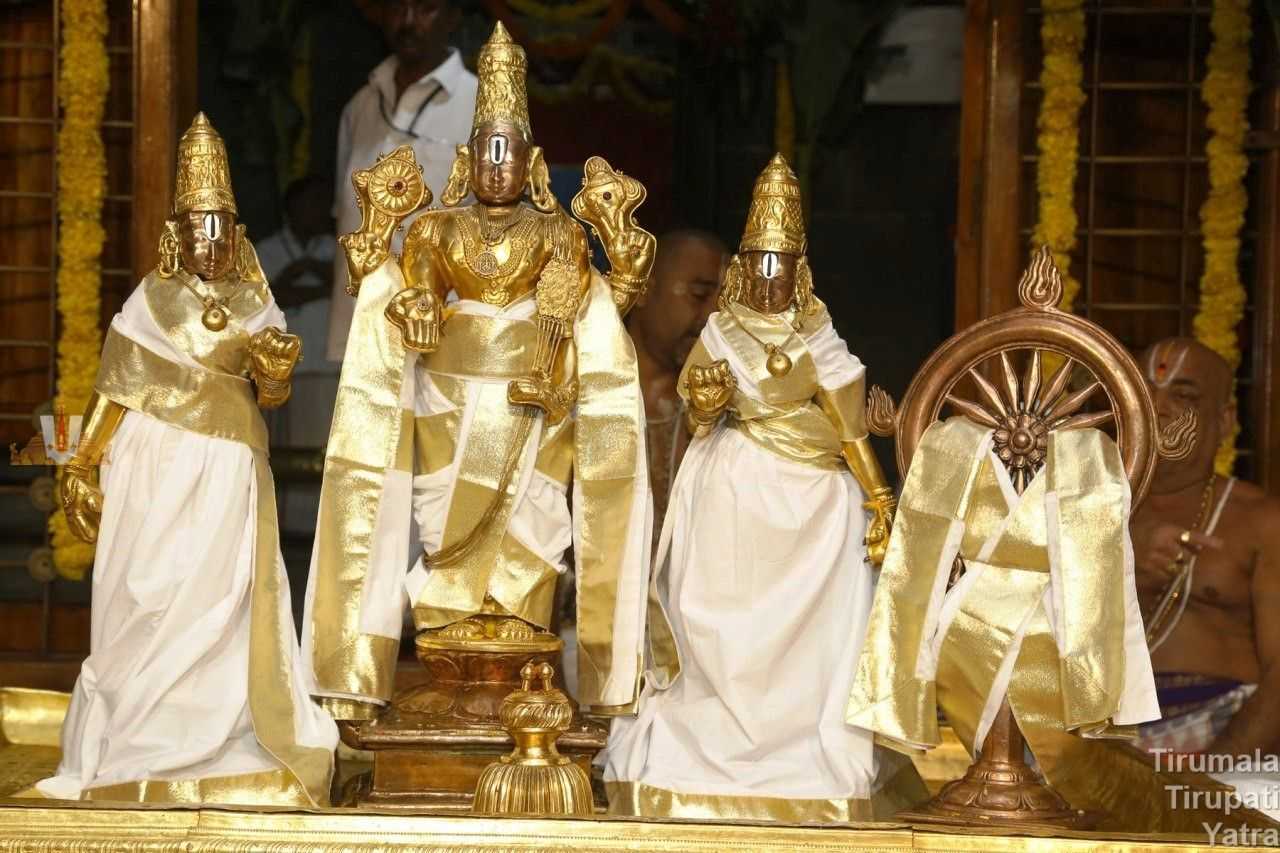
On the last day, Pallaki Seva and Chakrasnana Mahotsavam in the morning and Dhwajavarohanam are performed in the evening.
The processional images are anointed with oil, turmeric powder and other auspicious ingredients and Abhishekam is performed. Sudarsan Chakram is given a bath in the Swami Pushkarini. The Garuda flag is then lowered.
© 2023 kshetradarshan